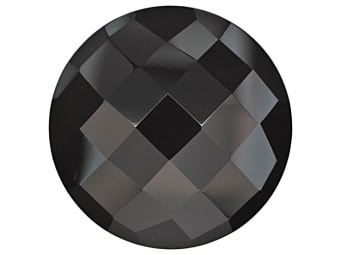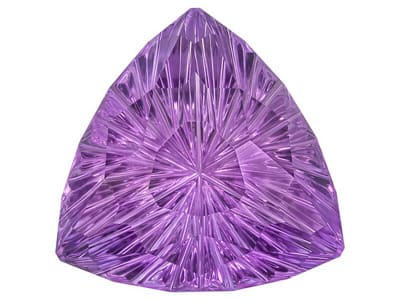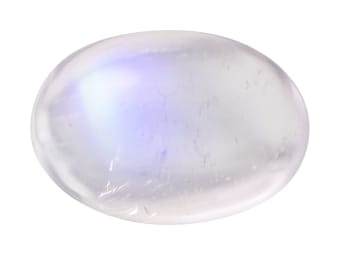What is Amethyst?
Amethyst, the birthstone for February, has beautiful purple shades, ranging from reddish-purple to violet to pastel lavender. Amethyst crystallizes in volcanic rock cavities creating geodes. These are often cut to make gorgeous displays that are the perfect addition to your crystal collection or make for unique home décor
Amethyst FAQ
Here are answers to more frequently asked questions about February's birthstone:
What color is February's birthstone?
The range of purple that this February birthstone comes in is far from simple. With amethyst, light lavender shades are possible as well as bold grape or plum colored gems.
Amethyst gets its purple coloration from iron and manganese in the quartz structure. Colors can vary throughout a crystal, depending on the concentration of these components. Some stones are bi-color, showing off different shades of purple in the same stone. Ametrine, a bi-color quartz with amethyst and citrine, has a color blend between purple and yellow.

What is the spiritual meaning of amethyst?
The name, amethyst, actually comes from one of the early beliefs about the stone’s properties. The greek word amethystos means “not drunk.” Amethyst supposedly had a sobering effect. Placed in a goblet, amethyst would prevent people from acting too foolishly while drunk. The effect was said to help with other desires as well. Wearing amethyst would help the wearer keep a level head and make rational decisions.
Egyptians, Romans and Greeks associated the purple of amethyst with wisdom and peace. Amethyst was a stone worn into battles, because of its supposed ability to increase one’s courage as well. Leonardo Da Vinci claimed that amethyst helped a person think on their feet and react wisely.
Altogether, amethyst is a calming stone with rich spiritual meanings.
Where is amethyst found?
At one time in history, this February birthstone was as rare and as valued as emeralds and rubies. As time has gone on, gemologists have found more amethyst in other places, such as Africa.
Brazil continues to produce the most amethyst. However, some of the largest deposits of amethyst have been found in the Americas. Sri Lanka, Australia and Uruguay can also boast of having this precious gemstone in their mines.
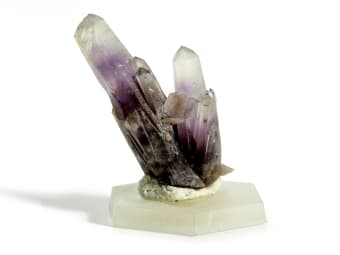
Are amethysts valuable?
At one time in history, this February birthstone was as rare and as valued as emeralds and rubies. However, more deposits have been found in recent times. While this doesn’t undermine the beauty of the amethyst, it is significant when it comes to cost.
Unlike most other gemstones, the size of an amethyst does not necessarily correlate with cost. Larger amethysts are nearly as common as smaller cuts of gem quality amethyst, and only differ slightly in price as carat weight increases.
The most valuable feature to an amethyst is cut and color. If it has a deep purple coloration, the amethyst is likely to be 3 to 5 times more expensive than lighter amethyst of the same quality. Its value depends on any visible inclusions it has and whether or not the dark purple isn’t so dark that it appears black in low lighting.
What are the different species of amethyst?
Amethyst only comes in purple, but some of the varieties of amethyst have earned names for their unique colorations. Although some of them have location-based names, like Uruguyan amethyst, it's possible to find amethyst with this coloration in other places in the world. However, such discoveries can be uncommon.
- Ametrine- This combination of amethyst and citrine is cut to show a breathtaking blend of yellow and purple. Citrine also is a part of the quartz family, so the transition between colors is seamless and stunning.
- Rose de France Amethyst- The Rose de France amethyst is a color variety of light lavendar or lilac shades of purple. This variety is more subtle, but is loved by collectors and jewelry wearers.
- Siberian Amethyst- This species of amethyst is purple with hints of mostly blue but some red undertones. Siberian amethyst has a regal coloration that looks beautiful set in gold.
- Uruguyan Amethyst- Possibly one of the rarest of all amethyst. Uruguayan amethyst is found in the Artigas region of Uruguay. Their darker purple gives them higher value than most lighter amethyst.
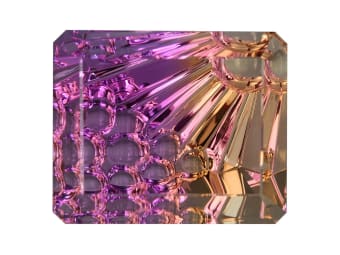
What is the history behind amethyst?
Amethyst was a stone adored by ancient civilizations long before it was a birthstone for February. Inside King Tut’s tomb, archaeologists uncovered amethyst among the king’s gems. In the Middle Ages, amethyst served as a beautiful decoration piece in churches. Even Saint Valentine wore an amethyst ring, bringing this stone into association with the saint’s holiday, Valentine’s Day.
One of the more famous stories surrounding this stunning purple stone is the Greek myth of the nymph Amethystos. Dionysus, the god of intoxication and revelry, decided that he wanted Amethystos, but she did not feel the same. As she fled from him, she prayed that the goddess of virginity and chastity, Artemis, would find a way to protect her.
Artemis heard her prayers. Amethystos was turned into quartz, which thwarted Dionysus’s plans to be with her. When he found her, Dionysus remorsefully poured out a cup of wine over the clear quartz statue, dyeing Amethystos purple.
What a colorful legend behind such a stunning gemstone.
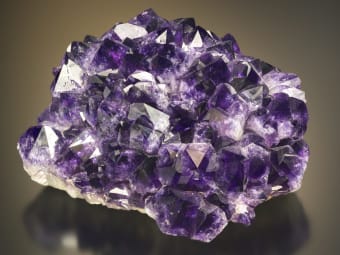
Did you know... Saint Valentine wore a ring of amethyst, engraved with an image of Cupid? Because of his belief in the virtue of love and marriage, amethyst is associated with romance and is the perfect stone for new couples.
Amethyst Gemstone Properties
For more facts and information about the characteristics of the February birthstone, check out the Amethyst Gemopedia page.
Physical Properties of Amethyst
Amethyst is a 7 out of 10 on the Mohs Hardness Scale, which makes it a durable gem for jewelry. Amethyst form in hexagonal crystals. Clusters of these crystals can grow to be quite large. The coloration can vary, depending if iron and manganese are present. Gemstones are cut to keep the color of the stone uniform. But bi-color cuts showcase the color gradient from lavender to bold purple.
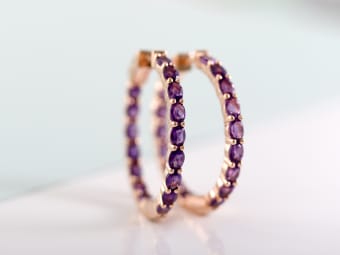
Healing Properties and Benefits of Amethyst
Amethyst is believed to be a protective gemstone. It is said to provide mental clarity, promote calmness and distinguish between rational and irrational thought. Curing insomnia, strengthening the immune system, easing tension in the body and healing bruises and abrasions... those are just a few of the curative properties associated with amethyst.
Did you know... The Empress of Uruguay is the largest amethyst formation found to date? The geode stretches to 11 feet tall and weighs well over 5,000 pounds.
Amethyst Birthstone Jewelry and Gifts
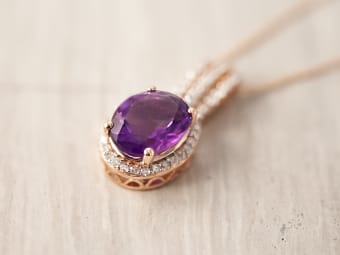
Amethyst February Birthstone Jewelry Buyers' Guide
The soft and moving tones of amethyst are the perfect way to celebrate those February babies out there with style. Although amethyst only comes in purple, you're sure to find a shade that matches your style. Light lavender amethyst is a simple addition to any outfit, especially against red. A deeper purple amethyst is perfect for a cool color scheme with blue and green accents.
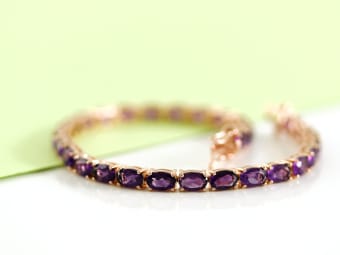
More Amethyst Gift Ideas
Amazing amethyst is a gemstone for everyone, even people who weren’t born in February. Amethyst has a splash of purple pride that will give you steady confidence and a stylish look for wherever life takes you. From lighter colors to deep dark purples, amethyst to make you feel as stunning as you already are. Whatever you’re looking for, we’re fairly confident that we’ll find a jewelry piece for you, with undeniable joy in its sparkle.
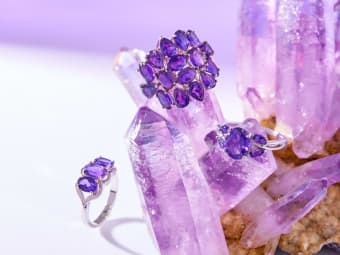
February Birthstone Alternatives
If purple amethyst isn’t to your liking, why not try February birthstone alternatives like black onyx and moonstone. These gemstones are elegant and classy statement pieces to wear with anything in your wardrobe.
Unique and edgy, black onyx is believed to absorb negative energy. On the other end of the spectrum is the magnificent moonstone. This white February birthstone has an iridescent shine that brings the luck of rainbows and the purity of white together.
